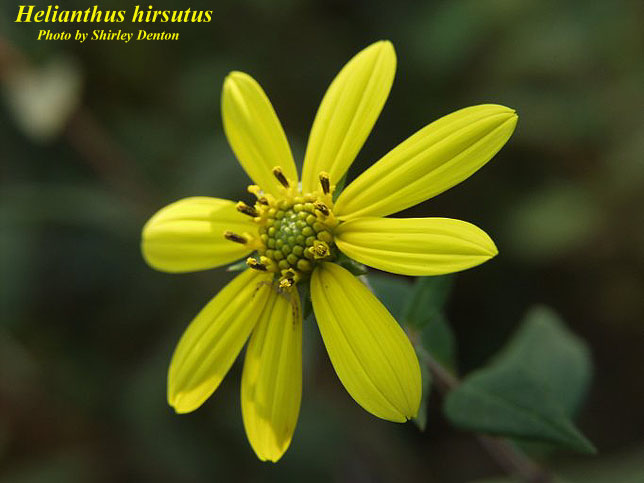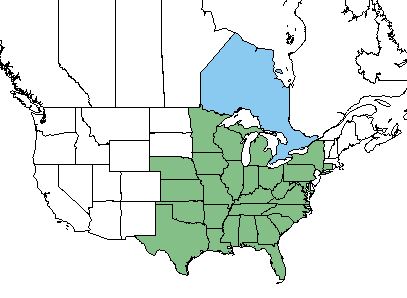Helianthus hirsutus
Common names: hairy sunflower; rough sunflower; coarse sunflower; woodland sunflower
| Helianthus hirsutus | |
|---|---|

| |
| Photo by the Atlas of Florida Plants | |
| Scientific classification | |
| Kingdom: | Plantae |
| Division: | Magnoliophyta - Flowering plants |
| Class: | Magnoliopsida - Dicots |
| Order: | Asterales |
| Family: | Asteraceae |
| Genus: | Helianthus |
| Species: | H. hirsutus |
| Binomial name | |
| Helianthus hirsutus Raf. | |

| |
| Natural range of Helianthus hirsutus from USDA NRCS Plants Database. | |
Contents
Taxonomic Notes
Synonyms: none.[1]
Varieties: none.[1]
Description
H. hirsutus is a perennial forb that is native to the United States.[2] It reaches heights between 12 to 18 inches tall with finely toothed leaves. Leaves and stems bristly; ray flowers yellow and 1 inch in length, and disk flowers brownish to yellow in color.[3]
Distribution
While H. hirsutus is present throughout much of the United States, it is most common in the central U.S. states like Missouri, Illinois and Arkansas.[2] It's distribution is from Pennsylvania and Minnesota south to northern Florida and Texas.[4] This species has also been introduced to the canadian province of Ontario.[2]
Ecology
Habitat
H. hirsutus typically grows in "woodlands and other sunny or semi-sunny habitats" [4]. It has been frequently found in ecotones at the edges of hardwood and mixed woodland forests. This species can grow in dry and moist loamy and rocky soil. It also grows in disturbed areas and areas that are burned regularly.[5] As well, it is considered a characteristic species of the shortleaf pine-oak-hickory community in the Red Hills Region of southern Georgia and northern Florida.[6]
Associated species include Polymnia uvedalia, Coreopsis tripteris, Collinsonia serotina, Helianthus microcephalus, Desmodium sp., Rudbeckia sp., Verbesina sp., Silphium asteriscus, and others.[5]
Phenology
This species flowers from July through October.[4] It has been observed to flower in July.[7]
Fire ecology
This species can be found in areas that are burned regularly [5]. It responds positively to fire, increasing in numbers after frequent fires.[8] This is due to its rapid spread of creeping roots that are in response to a fire disturbance.[9] As well, it benefits most from a high fire return interval.[10]
Pollination and use by animals
Helianthus hirsutus is visited by pollinators such as the ground-nesting bee Andrena accepta (family Andrenidae) and bees from the Apidae family such as Melissodes dentiventris and M. tincta.[11] It is considered by pollination ecologists to be of special value to native bees since it attracts such large numbers for pollination.[3] H. hirsutus is a much palatable species for white-tailed deer. [12]
Conservation, cultivation, and restoration
This species is considered vulnerable in North Carolina, Virginia, Iowa, and Michigan, considered imperiled in Pennsylvania, and considered an exotic species in New York and Ontario.[13]
Cultural use
Photo Gallery
References and notes
- ↑ 1.0 1.1 Weakley, A.S. 2015. Flora of the southern and mid-atlantic states. Working Draft of 21 May 2015. University of North Carolina at Chapel Hill, Chapel Hill, North Carolina.
- ↑ 2.0 2.1 2.2 USDA Plants Database URL: https://plants.usda.gov/core/profile?symbol=HEHI2
- ↑ 3.0 3.1 [[1]] Lady Bird Johnson Wildflower Center. Accessed: May 21, 2019
- ↑ 4.0 4.1 4.2 Weakley, A. S. (2015). Flora of the Southern and Mid-Atlantic States. Chapel Hill, NC, University of North Carolina Herbarium.
- ↑ 5.0 5.1 5.2 Florida State University Robert K. Godfrey Herbarium database. URL: http://herbarium.bio.fsu.edu. Last accessed: May 2018. Collectors: Loran C. Anderson, M. Morgan, Delzie Demaree, A. F. Clewell, Paul L. Redfearn Jr., Kathleen Craddock Burks, Gary R. Knight, Harry E. Ahles, J. A. Duke, R. D. Houk, Scott McCoy, Wilbur H. Duncan. W. C. Holmes, John B. Nelson, D. A. Raynerm S.W. Leonard, J. Moore, Norlan C. Henderson, George T. Jones, H.R. Bennett, D. S. Correll, H. B. Correll, Charles S. Willis, Carol L. Howel, Kevin Oakes, Richard Gaskall, J. M. Kane, Billie Bailey, Bob Farley, Brian R. Keener, R. Kral, and George Apthorp. States and Counties: Alabama: Cullman, Crenshaw, and Sumter. Arkansas: Garland, Conway, Logan and Lonoke. Florida: Clark, Jackson Leon, Gadsden, and Wakulla. Georgia: Butts, Thomas and Madison. Indiana: Harrison, Lake, Sullivan and Porter. Louisiana: Natchitoches. Missouri: Johnson, CassStone, Laclede, Greene, Douglas, and Clinton. North Carolina: Haywood and Nash. Ohio: Erie. Oklahoma: Latimer. South Carolina: Abbeville and York. Texas: Bowie and Newton.
- ↑ Clewell, A. F. (2013). "Prior prevalence of shortleaf pine-oak-hickory woodlands in the Tallahassee red hills." Castanea 78(4): 266-276.
- ↑ Nelson, G. PanFlora: Plant data for the eastern United States with emphasis on the Southeastern Coastal Plains, Florida, and the Florida Panhandle. www.gilnelson.com/PanFlora/ Accessed: 21 MAY 2019
- ↑ Sparks, J. C., et al. (1998). "Effects of late growing-season and late dormant-season prescribed fire on herbaceous vegetation in restored pine-grassland communities." Journal of Vegetation Science 9: 133-142.
- ↑ Hartman, G. W. and B. Heumann (2003). Prescribed fire effects in the Ozarks of Missouri: the Chilton Creek Project 1996-2001. Second International Wildland Fire Ecology and Fire Management Congress and Fifth Symposium on Fire and Forest Meteorology, Orlando, FL, American Meteorological Society.
- ↑ Mehlman, D. W. (1992). "Effects of fire on plant community composition of North Florida second growth pineland." Bulletin of the Torrey Botanical Club 119(4): 376-383.
- ↑ Discoverlife.org [2]
- ↑ Burton, J. A. (2009). Fire frequency effects on vegetation of an upland old growth forest in eastern Oklahoma. Environmental Science. Stillwater, Oklahoma, Oklahoma State University. Bachelor: 78.
- ↑ [[3]] NatureServe Explorer. Accessed: May 21, 2019